Introduction
The term ” nutraceutical (NC) ” is derived from “nutrition” and “pharmaceutics.” It refers to items extracted from particular diets, dietary supplements (nutrients), herbal products and processed foods such as drinks, soups and cereals that are utilized as medicine in addition to nutrition 1. In the United States, nutraceuticals are regarded as pharmaceuticals, food additives, and dietary supplements. Although not defined the same way in every country, nutraceuticals are often described as a substance extracted from foods to be offered medically 1,2.The nutraceutical product is known as a chemical which can provide physiological advantages or lessen chronic illnesses. Nutraceuticals can improve health, prevent chronic illnesses, slow the aging process, extend life, keep the body’s structure, or function the same, or keep it healthy. As opposed to medicines, NCs are compounds that generally do not have patent protection. Both pharmaceutical and nutraceutical chemicals may be used to treat or prevent illness, however, the government appears to only approve pharmaceutical compounds 3,4.
A dietary supplement is a product that includes or bears one or more of the following nutritional ingredients: A vitamin, a mineral, and an amino acid, a medicinal herb or other plant, a nutritional product for human use to supplement the diet by increasing total daily consumption, or a concentration, metabolite, component, extract, or a mixture of these constituents. Nutraceuticals are nutritional supplements that are utilized for reasons other than nourishment. Ginseng, glucosamine, lutein, echinacea, green tea, folic acid, omega-3 and cod liver oil are prominent NCs. The vast majority of NCs have various therapeutic effects. Nutraceuticals are gaining popularity owing to their potential nutritional, therapeutic benefits and safety,. According to a recent industry study, the global NC market will reach $250 billion by 2018 2,5-9.
Recent research has shown that these substances have promising benefits for a variety of pathological outcomes, including atherosclerosis, cardiovascular diseases (CVDs), neurological disorders, diabetes, and cancer. Many changes occur under these circumstances, including variations in the redox state. The majority of NCs include antioxidants that may help to mitigate this scenario. As a result, they are thought to be good sources of health promotion, especially to avoid diseases that could kill you, like diabetes, infections, kidney problems, and gastrointestinal problems 2,5,8-10. Hence, many studies have examined NCs by using different research or experiment methods or tools such as systematic review and meta-analysis to determine the impact of nano-curcumin supplementation with cardiovascular disease5, review of the safety and efficacy of curcumin with cardiac problems9, peroxidation models in vitro with Sicilian black honeybees23 , peroxidation models in vitrowith antioxidant activity of grape seed (Vitis vinifera) extracts32 , comparative study used solvent systems with phenolic substances and the antioxidant capacity of extracts from food legumes33 , vitro models with the antioxidant activity of pomegranate (Punica granatum) peel and seed extracts36 , and/or near infrared spectroscopy (NIRS) tool with nutraceutical quality control40. However, there is limited research using bibliometric analysis in examining NCs with functional food and/or different diseases. Thus, our current review is the first exploratory to examine all NCR from 1993 to 2023 by using bibliometric analysis. In research evaluation practices, researchers are encouraged to use high-quality and informative tools such as bibliometric methods11-15. Bibliometric techniques are regarded as valuable decision-making tools for following the progress of science and technology, determining research priorities, allocating funds and recognizing scientific brilliance, among other things. Because of their adaptability, these methodologies have rapidly extended outside the academic field and libraries. Where they originated, part of its expansion may be attributed to the availability of data and ease of access. Furthermore, the increase of processing and analytical tools of various complexities has made modern bibliometrics accessible to practitioners and scientists of all levels of competence 11-15.
The objective of the present study was to comprehensively examine the inception and current state of NCs. We also aimed to identify potential areas for future research by mapping current themes, exploring emerging trends, and identifying research gaps. We conducted a thorough bibliometric analysis of the NCR from its establishment to the present, as this type of analysis has yet to be undertaken. This analysis allowed us to assess the progress and development of research in the field and to provide valuable insights for researchers and decision-makers. The study focused on performance evaluation, conceptual mapping, trending subjects, and research needs in the NCR. The findings highlight the increasing recognition and appeal of these emerging disciplines within the scientific community and general population. Evaluating and assessing the research trajectory in the NCR is necessary to inform future directions and address research gaps.
Materials and Methods
This section is intended to provide a comprehensive description of the bibliometric analysis conducted in this study. This research provides additional information on the building of the corpus and the analysis of the data, with the aim of ensuring the study’s consistency, replicability, and transparency 16. The researchers employed the PRISMA guidelines 17 to establish the reporting pool using a three-stage approach consisting of identification, screening, and inclusion. The procedural stages for conducting this research are illustrated in Figure 1.
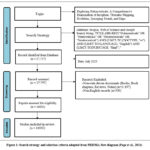 |
Figure 1: Search strategy and selection criteria adopted from PRISMA flow diagram (Page et al., 2021) |
Database selection and search strategy
The bibliometric study has extensively used several well-known bibliographic databases, including Scopus, Web of Science, and Google Scholar. The WoS database has been cited in a large body of prior research as having higher quality and broader document coverage 11,18, Still, the current study used the Scopus core collection database as the literature source for data retrieval. Compared to WoS, Scopus has more documents on the search topic used in this study. In the current study, data analysis was done using the Bibliometrix program. Combining datasets from several databases is not recommended, as stated by the creators of Bibliometrix, as each uses a distinct method to codify the bibliographic metadata. Additionally, Scopus must be more adaptable when indexing similar sources. Google Scholar provides broader indexing than WoS and Scopus, including unpublished papers among its citation sources 19. Google Scholar does not distinguish between academic and non-academic citations, which could lead to bias 15 and the discriminatory standards that the other two databases maintain 19, although it has a more thorough coverage of sources for citations.
The initial search yielded 27,757 documents across disciplines with the provided keywords when it was run in July 2023. The following is the data collection’s guiding principle: A keyword search was first carried out on Scopus. The title, keywords, and abstract comprised the search space. The most popular search phrases were “TITLE-ABS-KEY (“Nutraceuticals” OR “Nutriceuticals” OR “Neutraceuticals” OR “Neutraceutical”) AND (LIMIT-TO (DOCTYPE, “ar”) AND (LIMIT TO (LANGUAGE, “English”) AND (LIMIT-TO (PUBSTAGE, “final”).” These search terms were generated using the MesH database for scientific terminologies. By using the Boolean operator “AND,” all terms were connected. In the category, we utilized the Boolean operator “OR,” which denotes that any term meets the requirement. At this point, we did not set a time restriction for gathering data on how NCR studies have changed throughout the years.
Inclusion and exclusion criteria
To ensure the relevance of retrieved articles to the research topic, we followed specific steps to meet the inclusion criteria. First, we carefully reviewed the abstracts of highly cited papers and manually filtered out unrelated studies. After inspection of these highly cited articles, the document type and language refined the search. We first excluded all other kinds of documents, yielding 16560 documents. After a thorough review, book chapters were excluded from the research pool since they relate to relevant works dedicated to NCR. In addition, although English, German, Spanish and French were the most common languages in which these studies were published, the search was limited to the English language, due to the limitations in analyzing techniques. The final sample consisted of 16030 documents that were taken as research objects from the Scopus database.
Data analysis
Data obtained from the Scopus database was exported in BibTex format, entered Bibliometrix, and then transformed into an R data frame. The efficiency of Bibliometrix in conducting bibliometric investigations has been demonstrated in earlier studies. Following a logical bibliometric process and incorporating all key bibliometric analysis approaches, Bibliometrix is a unique R-tool for thorough scientific map analysis. It is used to assess a particular subject’s quantity and growth trend. Bibliometrix is a useful tool for evaluating the value of publications in a certain field over time, and can also assist researchers in tracking the performance of various topics 13,14,16,20.
Bibliometrics encompasses two widely utilized methodologies, namely performance analysis and science mapping. Using performance analysis, which is primarily descriptive, can assist those with a specific interest in a particular subject in understanding its underlying principles and current state of advancement. In addition to serving as an indicator of the progress of a particular field of inquiry, bibliometric analysis facilitates the identification of seminal articles and influential scholarly publications. Science mapping focuses on organizing and representing knowledge structures, enabling the visualization and analysis of complex interactions among various components. It is recommended to incorporate performance analysis and scientific mapping into bibliometric analysis 12,21. Therefore, we integrate performance measurement and knowledge mapping technologies into our current work. This research examines bibliometric analysis methodologies, which are categorized into three main categories of analysis: (1) performance analysis, (2) cooperation analysis, and (3) theme mapping. The initial aspect focuses on including research elements in accounting, while the subsequent two aspects delve into the evolving nature of the research sector. Bibliometrix employs a thematic map to elucidate the conceptual framework of a given subject. This map displays the identification of the primary areas of investigation within a scientific discipline, as well as the prevailing themes and patterns.
Results and Discussion
Since this research focuses only on NCs and uses carefully chosen keywords, the search yielded 16030 documents in the English language with data published in 2919 journals by 54108 authors (Table 1). The document co-authoring rate was 5.69. Nutraceuticals were first introduced in 1993, subsequently the number of documents involving NS significantly grew at an annual rate of 27.73%. The yearly growth of NCR was polynomially fitting (R2 = 0.929), as shown in Figure 2. In 2005, the research commenced to surpass the threshold of one hundred documents. In 2012, the number of documents exceeded the threshold of five hundred, while in 2018, it reached the point of one thousand documents. The analysis was conducted on August 20, 2023. The increased research in NCR can be attributed to the growing interest in preventive healthcare, consumer demand for natural approaches to health, expanding knowledge about the link between diet and health, technological advancements, commercial potential, and regulatory considerations. These factors have collectively fueled scientific exploration and contributed to our understanding of NCs’ potential benefits and applications in promoting health and well-being 1-3,22,23.
Table 1: Main information about data.
|
Timespan |
1993:2023 |
|
Sources (Journals, Books, etc) |
2919 |
|
Annual growth rate % |
5.33 |
|
Document average age |
5.88 |
|
Average citations per document |
24.41 |
|
Keywords Plus (ID) |
51138 |
|
Author’s Keywords (DE) |
30515 |
|
Authors |
54108 |
|
Authors of single-authored docs |
505 |
|
Single-authored documents |
612 |
|
Co-authors per documents |
5.69 |
|
International co-authorships % |
26.39 |
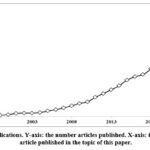 |
Figure 2: Annual publications. Y-axis: the number articles published. X-axis: the years since the first article published in the topic of this paper. |
Hotspots in NCR
The most prolific scholar in NCR is McClements, D.J., with 168 documents. He works for the University of Massachusetts’ Department of Food Science. He focuses on creating food-based, structured delivery systems for bioactive ingredients. He also has expertise in the fields of food biopolymers and colloids. His primary research focused on emulsion, creaming, emulsifying agents, nanocrystals, emulsions, the oil-water interface, characterization, kafirins, and caseinates. With 75 documents, Zengin, G., affiliated with the Faculty of Science, Selcuk University Campus, Turkey, booked the second spot. He leads a team studying Turkish medicinal plants’ biological activities. Their primary research interests include antioxidant activity, biotechnology, phytochemicals, natural product chemistry, chromatography, medicinal and pharmaceutical chemistry, solvent extraction, and high-performance liquid chromatography 8,10,24. Novellino, E., and Tenore, G.C., from the Department of Pharmacy, University of Napoli Federico II, Italy, were ranked third and fourth, with 58 and 52 documents, respectively. These two Italian scientists were among the pioneers in informing their colleagues about the distinct definition of NC, which distinguishes it from other classifications related to food, such as herbal products, probiotics, functional foods, food supplements, and fortified foods 25. A plethora of studies have contributed to the comprehension of probable mechanisms of action for pharmaceutically active chemicals found in food, which can enhance health, mitigate illness risk, and foster overall well-being 22,23,25.
The top ten productive scholars in the NCR are shown in Table 2. Unsurprisingly, Italy holds the top position, as it is home to five of the most productive institutes. The Italian researchers’ interest in NCR may stem from the prevalent utilization of natural goods and the commitment of research institutions to validating the authenticity of these products. The Scientific Association of Italian Pharmacists proposed in 2018 that there should be enhanced regulation of dietary supplements intended for health and nutritional purposes. This recommendation aims to address the potential for misuse of such supplements and reduce the current uncertainty and lack of guidance that pharmacists and citizens are experiencing 26. India and the USA are ranked second and third, with over two thousand documents. Food Chemistry, Molecules, and the Journal of Agricultural and Food Chemistry accommodated more than 1150 NCR-related documents. More details are shown in Table 2. Academic contributions have predominantly originated from advanced countries. Nevertheless, it would be highly encouraging to witness an increased output of research and scholarly contributions from emerging nations. Publications with a high impact factor have featured pieces pertinent to the topic. This underscores the significance that the academic community places on the literature on the NCR.
Figure 3. depicts the relationship between authors, courtiers, and sources based on the Sankey diagram. Sankey diagrams have been widely used to show the quantitative interrelationships and conversions between components within closed systems that take inputs and produce outputs. The diagram achieved considerable success and has a community with widespread applications across several domains 27. The influential country is China, based on the rectangular height on the diagram’s left side. Italy moved to seventh place. However, McClements, D.J., remained in first place as the most published author.
Table 2: Hotspot in NCR (1993-2023).
|
Country |
N |
Affiliation |
N |
Authors |
N |
Source |
N |
|
Italy |
2566 |
National Research Council, Italy |
318 |
McClements, D.J. |
168 |
Food Chemistry |
474 |
|
India |
2510 |
University of Naples Federico II, Italy |
310 |
Zengin, G. |
75 |
Molecules |
373 |
|
United States |
2251 |
University of Massachusetts Amherst, USA |
212 |
Novellino, E. |
58 |
Journal of Agricultural And Food Chemistry |
323 |
|
China |
1670 |
Ministry of Education China |
195 |
Tenore, G.C. |
52 |
Nutrients |
249 |
|
Spain |
925 |
Central Food Technological Research Institute, India |
191 |
Cicero, A.F.G. |
49 |
Foods |
247 |
|
Canada |
691 |
University of Pisa, Italy |
181 |
Xiao, H. |
49 |
Journal of Food Biochemistry |
242 |
|
Brazil |
682 |
University of Milan, Italy |
178 |
Barros, L. |
48 |
Food Research International |
228 |
|
South Korea |
610 |
University of Bologna, Italy |
175 |
Ferreira, I.C.F.R. |
48 |
Antioxidants |
226 |
|
Mexico |
591 |
Spanish National Research Council |
168 |
Oboh, G. |
44 |
Journal of Functional Foods |
189 |
|
United Kingdom |
483 |
Academy of Scientific and Innovative Research, India |
143 |
Suleria, H.A.R. |
35 |
Food and Function |
184 |
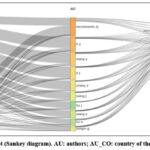 |
Figure 3: Three-field plot (Sankey diagram). AU: authors; AU_CO: country of the authors; SO: sources. |
The thickness of the lines connecting authors from different countries would represent the number of papers that they have co-authored. The thickness of the lines connecting countries and sources would represent the number of papers from each country that has been published in each source. Each rectangle represents a node. The size of the rectangle represents the importance of the node in the network. This figure was generated using the Bibliometrix application and the BibTex data file.
Collaborative efforts in NCR
Collaboration and partnerships are two terms employed to delineate the engagement of individuals and collectives from diverse backgrounds, possessing varied experiences, viewpoints, and ambitions, in the realm of research and development. There is a growing need from research funders for increased emphasis on interdisciplinary and collaborative research 28. However, the specific experiences related to these processes in the context of the NCR have not been well explored or addressed. The objective of this study was to enhance understanding of the collaborative, interdisciplinary, and partnership research process through an examination of researchers’ experiences and approaches to this process. The affiliation of the corresponding author serves as an indicator of whether the researchers have collaborated inside the same nation or across several nations on a particular subject area. Based on the data presented in Figure 4A, it can be observed that this subject matter has fostered global research collaboration among scholars. The results additionally indicate a collaboration that is evenly distributed. Nevertheless, there remains potential for growth, particularly inside developing and vibrant economies. This proposal aims to establish a comprehensive policy framework to effectively tackle the crucial issue of the NCR. The frequency of joint studies between countries is shown in Table 3. The most significant number of collaborative research endeavors (n = 330) were undertaken between the nations of China and the USA. Italy, Spain, and the USA have joined 272 joint research projects, following in the footsteps of China. The red lines depicted in Figure 4B provide a more thorough representation of global collaboration within the realm of NCR. The blue hue represents the quantity of research output generated by each respective country.
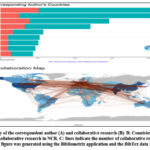 |
Figure 4: Country of the correspondent author (A) and collaborative research (B). B: Countries with blue color were new to the collaborative research in NCR. |
Table 3: Collaboration of countries on NCR
|
China |
USA |
330 |
|
Italy |
USA |
146 |
|
Italy |
Spain |
126 |
|
India |
USA |
120 |
|
USA |
Canada |
95 |
|
Egypt |
Saudi Arabia |
94 |
|
Spain |
Portugal |
85 |
|
Italy |
United Kingdom |
78 |
|
India |
Saudi Arabia |
73 |
|
Italy |
Germany |
72 |
|
China |
Canada |
70 |
|
USA |
Saudi Arabia |
67 |
|
Italy |
Turkey |
64 |
|
USA |
Korea |
62 |
|
Italy |
China |
61 |
|
USA |
Mexico |
59 |
|
USA |
United Kingdom |
59 |
|
Italy |
France |
58 |
|
USA |
Brazil |
51 |
|
USA |
Spain |
48 |
|
Pakistan |
Saudi Arabia |
45 |
|
Australia |
United Kingdom |
43 |
|
Italy |
Portugal |
43 |
|
USA |
Australia |
42 |
|
USA |
Germany |
41 |
|
Brazil |
Portugal |
40 |
|
India |
China |
39 |
|
China |
Korea |
38 |
|
China |
Pakistan |
38 |
|
China |
United Kingdom |
38 |
Most cited countries
A study of the nations with an impact on this topic found that the USA has the most influence among those that conduct scientific research. Spain, Canada, China, India, and Italy are the most influential countries. The results show that over 55% of the references come from the leading nations (Figure 5). The United States is often referenced in NCR due to its sophisticated healthcare system, comprehensive regulatory framework, and substantial consumer demand for dietary supplements. The nation’s robust scientific community, adequately financed research institutes, and synergistic partnerships between academia and industry all contribute to its eminence in the field of NCR 29.
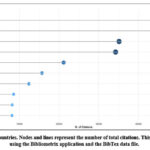 |
Figure 5: Most cited countries. Nodes and lines represent the number of total citations. This figure was generated using the Bibliometrix application and the BibTex data file. |
Most cited documents
Citations measure the effect of work; however, they are not the sole determinant of article impact. The limited number of citations received by the newer articles can be attributed to its relatively low readership 14. The frequency of sources for a publication tends to increase as time progresses. Table 4 provides a summary of the articles that have been cited. Most citations have been attributed to the research conducted by Huang et al 30. The utilization of the oxygen radical absorbance capacity (ORAC) assay has gained significant recognition as a standardized method for evaluating the antioxidant efficacy within the NC, pharmaceutical and food sectors. Huang devised a high-throughput instrument platform capable of fully automating the ORAC assay technique. The novel instrument platform comprises an automated eight-channel liquid handling system and a microplate fluorescence reader. In terms of citation average, the work by Yoshino et al. has gained first place. They studied the pathophysiology of diet- and age-induced diabetes in mice and the possible role of nicotinamide mononucleotide 31. The antioxidant properties of plant extracts, pharmaceutical formulations, and drug delivery routes are the most cited research directions 6,7,32-36.
Table 4: Top-cited documents
|
Rank |
Title |
Source |
Y |
C |
CA |
|
1 |
High-throughput assay of oxygen radical absorbance capacity (ORAC) using a multichannel liquid handling system coupled with a microplate fluorescence reader in 96-well format |
Journal of Agricultural and Food Chemistry |
2002 |
1228 |
55.82 |
|
2 |
Studies on the antioxidant activity of pomegranate (Punica granatum) peel and seed extracts using in vitro models |
Journal of Agricultural and Food Chemistry |
2002 |
1084 |
49.27 |
|
3 |
Antioxidant activity of grape seed (Vitis vinifera) extracts on peroxidation models in vitro |
Food Chemistry. |
2001 |
960 |
41.74 |
|
4 |
Nicotinamide mononucleotide, a key NAD + intermediate, treats the pathophysiology of diet- and age-induced diabetes in mice. |
Cell Metabolism |
2011 |
893 |
68.69 |
|
5 |
Emulsion-based delivery systems for lipophilic bioactive components. |
Journal of Food Science |
2007 |
791 |
46.53 |
|
6 |
A comparative study on phenolic profiles and antioxidant activities of legumes as affected by extraction solvents |
Journal of Food Science. |
2007 |
786 |
46.24 |
|
7 |
Food microstructure affects the bioavailability of several nutrients |
Journal of Food Science |
2007 |
753 |
44.29 |
|
8 |
Structural design principles for delivery of bioactive components in nutraceuticals and functional foods. |
Critical Reviews in Food Science and Nutrition |
2009 |
735 |
49.00 |
|
9 |
Radical scavenging and antioxidant activity of tannic acid. |
Arabian Journal of Chemistry |
2010 |
633 |
45.21 |
|
10 |
The care of the patient with amyotrophic lateral sclerosis: Drug, nutritional, and respiratory therapies (an evidence-based review): Report of the quality standards subcommittee of the American academy of neurology |
Neurology |
2009 |
618 |
41.20 |
Y: year of publication; C: citation count; CA: citation average.
Conceptual structure
Co-word analysis utilizes text-mining methodologies to examine the titles, abstracts, and keywords of publications. Co-word linkages refer to the identification of numerous keywords that co-occur inside the same articles. The association between keywords is established by analyzing the frequency of their co-occurrence in a corpus of articles 37. Table 5 shows the most frequent keywords found in research on PWB related to business and economics. For instance, the words “nutritional,” “antioxidant,” and “antioxidant activity” are crucial keywords that have been identified throughout the research work. Moreover, Figure 6 presents an overview of the most frequently occurring words during a specific time frame. Subsequently, several of the research hotspots were identified, including the terms “polyphenols,” “oxidative stress,” “functional foods,” and “bioactive compounds.” All of these are associated with a higher frequency of terms used in various works.
Table 5: The most common keywords used in NCR
|
Keywords |
Frequency |
Keywords |
Frequency |
|
Nutraceuticals |
2337 |
HPLC |
155 |
|
Antioxidant |
1559 |
Obesity |
152 |
|
Antioxidant activity |
1010 |
Apoptosis |
140 |
|
Polyphenols |
552 |
Encapsulation |
133 |
|
Oxidative stress |
418 |
Cytotoxicity |
132 |
|
Functional foods |
403 |
Bioactive peptides |
129 |
|
Phenolic compounds |
379 |
DPPH |
129 |
|
Flavonoids |
369 |
Bioavailability |
126 |
|
Phenolics |
271 |
Nutrition |
125 |
|
Bioactive compounds |
268 |
Diabetes |
122 |
|
Inflammation |
257 |
Probiotics |
119 |
|
Phytochemicals |
226 |
Stability |
118 |
|
Carotenoids |
215 |
Antimicrobial activity |
117 |
|
Anthocyanins |
204 |
Extraction |
116 |
|
Curcumin |
204 |
Bioaccessibility |
115 |
|
Fatty acids |
199 |
Dietary supplements |
111 |
|
Antioxidant capacity |
193 |
Quercetin |
107 |
|
Microalgae |
167 |
Nanoparticles |
103 |
|
Resveratrol |
165 |
Response surface methodology |
103 |
|
Anti-inflammatory |
162 |
Antimicrobial |
101 |
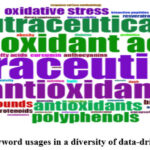 |
Figure 6: Keyword usages in a diversity of data-driven documents |
Thematic map
Co-word analysis creates keyword clusters, subsequently recognized as themed 13. Figure 7 of the schematic diagram displays the density on the vertical axis. This measures how closely related a cluster of themes is to one another. The lateral vertical axis, which displays how many other functional foods are connected to the NC, symbolizes its centrality. A theme illustrates a cluster’s density and centrality. Thematic maps are simple-to-understand diagrams that help examine different subjects in relation to the part they are positioned in. Fundamental concerns are covered in the lower right quadrant, with antioxidant activity, antioxidants, and polyphenols being the most significant. No NCR subjects were displayed in the upper-right quadrant for motor themes. There are no topics in the lower-left quadrant, which also comprises emerging or fading themes. Finally, very specialized or niche topics like Curcumin, encapsulation, and bioavailability are in the upper-left quadrant (Table 6). The encapsulation, bioavailability, and stability of curcumin nanoparticles were intensively investigated. As an NC agent, Curcumin was reported to impact risk factors for diabetes, pre-diabetes, metabolic syndrome, hypertension, obesity and hypercholesterolemia 9. The bioavailability of Curcumin is limited in regular dietary sources due to its chemical composition. Numerous approaches have been devised to enhance the bioavailability of Curcumin, one of which involves the utilization of nano-curcumin formulation. The administration of nano-curcumin supplements showed a positive correlation with enhanced glycemic control, as evidenced by decreased fasting blood glucose and fasting insulin 5. He distribution of themes relating to NC and oxidative stress among the four squares was neutral. This finding implies that NCR is still growing to reach its final stage of development.
Thematic maps are divided into four quadrants based on centrality and density, which represent the importance and development of research topics. This figure was generated using the Bibliometrix application and the BibTex data file.
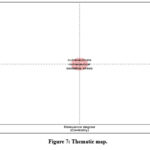 |
Figure 7: Thematic map. |
Thematic maps are divided into four quadrants based on centrality and density, which represent the importance and development of research topics. This figure was generated using the Bibliometrix application and the BibTex data file.
Table 6. Clusters in the thematic map and their respective terms.
|
No |
Cluster label |
Terms |
Theme |
NW |
|
1 |
Nutraceuticals |
Nutraceuticals, nutraceutical , oxidative stress , inflammation , functional foods , functional food , microalgae , resveratrol , obesity , apoptosis , nutrition , diabetes , probiotics , dietary supplements , quercetin , astaxanthin , cancer , molecular docking , lycopene , osteoarthritis |
Neutral |
20 |
|
2 |
Antioxidant activity |
Antioxidant activity, antioxidant, antioxidants , polyphenols , phenolic compounds , flavonoids , phenolics , bioactive compounds , phytochemicals , carotenoids , anthocyanins , fatty acids , antioxidant capacity , anti-inflammatory , hplc , cytotoxicity , bioactive peptides , dpph , antimicrobial activity , extraction , response surface methodology , antimicrobial , metabolomics , anthocyanin , phenols , antibacterial , anticancer , flavonoid |
Basic |
28 |
|
3 |
Curcumin |
Curcumin, encapsulation , bioavailability , stability , bioaccessibility , nanoparticles |
Niche |
6 |
NK: number of keywords in each cluster
Thematic evolution
We conducted a theme analysis to better understand how the field has changed. To do this, we looked at the keywords used by the authors during two time-periods (Figure 8) to identify themes, which are then sorted by Callon’s density (Y-axis) and centrality (X-axis) rank values. The following settings were made during the analysis: word minimum frequency was set to 5, 250 words were used in the analysis, there were two labels for each cluster, and a customized stop word list was used to weed out terms that were not relevant to the study. Antioxidants, NCs, and curcumin are the main research AREAS before 2020. These research themes were further accompanied by antioxidant activity as a new theme after 2020. Nutraceuticals diverged into three clusters after 2020. Antioxidant activity as a new theme was originally split from antioxidants (Figure 8).
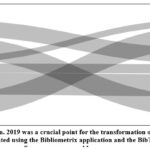 |
Figure 8: Thematic evolution. 2019 was a crucial point for the transformation of the main topics. This figure was generated using the Bibliometrix application and the BibTex data file. |
Trending topics
Bibliometric methods help some shed light on current research trends. Since its inception, bibliometrics has been influenced by a wide range of metrics, from counting publications or citations to fusing the trinity of indexation, citations, and publications by employing various algorithms 20,38. The current study analyzed the author’s keywords to explore the trending topics in NCR (Figure 9). Castanea sativa, authentication, lipophilicity, bioactive compounds, molecular docking, COVID-19, autophagy, gut microbiota, and sustainability are the trending topics in NCR. Some trending topics have the most extended lifespan, such as β-glucosidase, rice bran oil, low-density lipoproteins (LDL), phytomedicine, β-lactoglobulin, structured lipids, and the elderly (Figure 9). The macronutrient content of the C. sativa bur has significant relevance in terms of the possible use of this dietary by-product as a NC 39. The current study also revealed that authentication of NCs is a trending theme. The issue of ensuring quality control and authenticity of NCs has long been a formidable undertaking, primarily because to the intricate composition and extensive range of variability associated with these products 40.
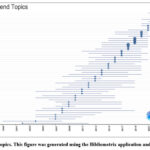 |
Figure 9: Trending topics. This figure was generated using the Bibliometrix application and the BibTex data file. |
Conclusion
This current study provided a rigorous bibliometric analysis in relation to thoroughly evaluate and map current state of NCR. In addition, potential areas for future research have been explored by mapping out current themes, exploring evolution, emerging trends, and gaps. Future research could determine and investigate the emerging trends and research gaps from the current bibliometric analysis. Technological advancements have greatly aided the field of NCR by providing researchers with a variety of more precise analytical techniques, tools for molecular profiling, computational modeling expertise, improved in vitro and in vivo models, and enhanced capacities for data gathering and analysis. These improvements have played a significant role in enhancing our comprehension of NCs, elucidating their mechanisms of action, and exploring their potential uses in promoting health and well-being. Because of the increased interest in natural health products and their potential advantages to human health, antioxidant research is becoming more prominent in the NCR. Antioxidants in various foods and supplements have been extensively researched for their capacity to counteract oxidative stress and lower the risk of chronic diseases. Curcumin is considered a significant NC product because of its extensive health advantages. It possesses considerable antioxidant, anti-inflammatory, and anticancer capabilities, rendering it desirable for enhancing general well-being and potentially mitigating the onset of chronic ailments.
The field of NCR has achieved notable advancements, yet some areas still need to be explored or addressed. For example, implementing standardized rules is necessary since it would result in potential disparities in manufacturing processes, quality control measures, and labeling practices. The availability of substantial clinical evidence currently needs to be improved, necessitating the implementation of well-planned studies to establish the effectiveness and safety of the intervention. Further investigation is necessary to fully comprehend the intricate mechanisms through which NCs exert their effects. Additionally, there is a need for research endeavors that delve into the interactions and synergistic impacts of bioactive chemicals. Furthermore, it is imperative to thoroughly examine individual variances in response, long-term consequences, and safety profiles. Complementary qualitative evaluations and contextual information are required to understand the research landscape comprehensively. When conducting bibliometric studies, for instance, more research is required concerning social influences, collaborations, and funding resources to obtain a holistic understanding. Further research is also needed to adequately account for multidisciplinary collaborations and publications to evaluate research trends and their impact. Lastly, advanced research might be necessary to examine the documentation process of bibliometric studies including preprints, open access, and alternative publishing models of scholarly communication.
By addressing these gaps, the evidence base will be strengthened, individualized approaches will be enhanced, and the safe and effective utilization of NCs to enhance human health will be ensured. Based on a quantitative review of scholarly articles, this study makes recommendations. Finding influential authors, well-liked research areas, and collaboration opportunities are some of its advantages for researchers. Decision-makers can use this information to guide policy, funding, and resource allocation, resulting in more strategic and informed choices.
Limitations
Bibliometric studies, which examine patterns and tendencies in scientific publications, have gained popularity as instruments for assessing the impact and productivity of research. While they provide insightful information, it is essential to recognize their limitations. First, bibliometric research is susceptible to publication bias. They rely on published literature, which is frequently biased toward positive results and may exclude unpublished or non-English-language research. This can result in a more balanced representation of the research landscape. Second, bibliometric analyses concentrate predominantly on quantitative metrics such as citation counts, h-index, and journal impact factors. However, these metrics must comprehensively evaluate research quality, significance, and relevance. They must capture the nuances of the research’s content, methodology, and impact on the actual world. In addition, bibliometric studies frequently require additional contextual information.
For interpreting the implications and limitations of bibliometric findings, context is necessary. In addition, the accessibility and scope of databases impose constraints on bibliometric analyses. The selection of databases may introduce bias and neglect pertinent publications, especially in emerging fields, non-traditional outlets, or disciplines with limited database coverage. In addition, bibliometric studies may need to capture interdisciplinary research more effectively. They frequently rely on disciplinary classification systems that must adequately account for multidisciplinary collaborations and publications, resulting in an incomplete evaluation of research trends and their impact. Lastly, bibliometric studies require assistance in documenting the dynamic landscape of scholarly communication, which includes the rise of preprints, open access, and alternative publishing models. These emerging practices challenge conventional bibliometric techniques and require thorough analysis. In conclusion, although bibliometric studies provide vital insights into the productivity and impact of research, they must be interpreted with caution due to their limitations.
Funding Sources
The authors extend their appreciation to the Deputyship for Research Innovation, Ministry of Education in Saudi Arabia for funding this research work through the project number ISP23-82.
Conflicts of Interest
The authors declare no conflict of interest.
Authors’ Contribution
SIH participated in formulating the research question of this article, collected and analysed the studies, prepared the draft of this review article. MMET and AAM updated and integrated, analysed and reviewed studies, and edited the manuscript. MF and HS assisted in critically reviewed manuscript, edited, and refined the completed article.
Data Availability
All data associated with this study will be available based on the reasonable request to corresponding author.
Ethics Statement
Not applicable
Informed Consent Statement
Not applicable.
References
- Kalra E. K. Nutraceutical–definition and introduction. AAPS pharmSci. 2003;5(3):E25.
CrossRef - Nasri H., Baradaran A., Shirzad H., Rafieian-Kopaei M. New concepts in nutraceuticals as alternative for pharmaceuticals. International journal of preventive medicine. 2014;5(12):1487-1499.
- Chauhan B., Kumar G., Kalam N., Ansari S. H. Current concepts and prospects of herbal nutraceutical: A review. Journal of advanced pharmaceutical technology & research. 2013;4(1):4-8.
CrossRef - Zeisel S. H. Regulation of “nutraceuticals”. Science (New York, NY). 1999;285(5435):1853-1855.
CrossRef - Ashtary-Larky D., Rezaei Kelishadi M., Bagheri R., et al. The Effects of Nano-Curcumin Supplementation on Risk Factors for Cardiovascular Disease: A GRADE-Assessed Systematic Review and Meta-Analysis of Clinical Trials. Antioxidants (Basel, Switzerland). 2021;10(7).
CrossRef - McClements D. J., Decker E. A., Park Y., Weiss J.. Structural design principles for delivery of bioactive components in nutraceuticals and functional foods. Critical Reviews in Food Science and Nutrition. 2009;49(6):577-606.
CrossRef - Parada J., Aguilera J. M. Food microstructure affects the bioavailability of several nutrients. Journal of Food Science. 2007;72(2):R21-R32.
CrossRef - Šamec D., Loizzo M. R., Gortzi O., et al. The potential of pumpkin seed oil as a functional food-A comprehensive review of chemical composition, health benefits, and safety. Comprehensive reviews in food science and food safety. 2022;21(5):4422-4446.
CrossRef - Surma S., Sahebkar A., Urbański J., Penson P. E., Banach M. Curcumin – The Nutraceutical With Pleiotropic Effects? Which Cardiometabolic Subjects Might Benefit the Most? Frontiers in Nutrition. 2022;9.
CrossRef - Feng X., Sureda A., Jafari S., et al. Berberine in Cardiovascular and Metabolic Diseases: From Mechanisms to Therapeutics. Theranostics. 2019;9(7):1923-1951.
CrossRef - AlRyalat S. A. S., Malkawi L. W,. Momani S. M. Comparing bibliometric analysis using PubMed, Scopus, and Web of Science databases. JoVE (Journal of Visualized Experiments). 2019(152):e58494.
CrossRef - Baker H. K., Pandey N., Kumar S., Haldar A. A bibliometric analysis of board diversity: Current status, development, and future research directions. Journal of Business Research. 2020;108:232-246.
CrossRef - Beylik U., Palteki T. Thematic development of research on patient safety: An analysis with the science mapping technique. Northern clinics of Istanbul. 2022;9(2):188-196.
CrossRef - Brandt J. S., Hadaya O., Schuster M., Rosen T., Sauer M. V., Ananth C. V. A Bibliometric Analysis of Top-Cited Journal Articles in Obstetrics and Gynecology. JAMA network open. 2019;2(12):e1918007.
CrossRef - De Bellis N. Bibliometrics and citation analysis: from the science citation index to cybermetrics. scarecrow press; 2009.
- Gusenbauer M., Haddaway N. R. Which academic search systems are suitable for systematic reviews or meta-analyses? Evaluating retrieval qualities of Google Scholar, PubMed, and 26 other resources. Research synthesis methods. 2020;11(2):181-217.
CrossRef - Page M. J., McKenzie J. E., Bossuyt P. M., et al. The PRISMA 2020 statement: An updated guideline for reporting systematic reviews. International journal of surgery (London, England). 2021;88:105906.
CrossRef - Donthu N., Kumar S., Mukherjee D., Pandey N., Lim W. M. How to conduct a bibliometric analysis: An overview and guidelines. Journal of business research. 2021;133:285-296.
CrossRef - Roemer R. C., Borchardt R. Meaningful metrics: A 21st century librarian’s guide to bibliometrics, altmetrics, and research impact. Amer Library Assn; 2015.
- Liu Z. Mapping the research trends of third language acquisition: A bibliometric analysis based on Scopus. Frontiers in Psychology. 2022;13.
CrossRef - Aria M., Misuraca M., Spano M. Mapping the evolution of social research and data science on 30 years of social indicators research. Social indicators research. 2020;149:803-831.
CrossRef - Tenore G. C., Campiglia P., Stiuso P., Ritieni A., Novellino E. Nutraceutical potential of polyphenolic fractions from Annurca apple (M. pumila Miller cv Annurca). Food chemistry. 2013;140(4):614-622.
CrossRef - Tenore G. C., Ritieni A., Campiglia P., Novellino E. Nutraceutical potential of monofloral honeys produced by the Sicilian black honeybees (Apis mellifera ssp. sicula). Food and chemical toxicology : an international journal published for the British Industrial Biological Research Association. 2012;50(6):1955-1961.
CrossRef - Sharmeen J. B., Mahomoodally F. M., Zengin G., Maggi F. Essential Oils as Natural Sources of Fragrance Compounds for Cosmetics and Cosmeceuticals. Molecules (Basel, Switzerland). 2021;26(3).
CrossRef - Santini A., Cammarata S. M., Capone G., et al. Nutraceuticals: opening the debate for a regulatory framework. British journal of clinical pharmacology. 2018;84(4):659-672.
CrossRef - Brunelli L., Arnoldo L., Mazzilis G., et al. The knowledge and attitudes of pharmacists related to the use of dietary supplements: An observational study in northeastern Italy. Preventive medicine reports. 2022;30:101986.
CrossRef - de-Córdoba G. F., Molinari B. Sankey diagrams for macroeconomics: A teaching complement bridging undergraduate and graduate Macro. Heliyon. 2022;8(9):e10717.
CrossRef - Nyström M. E., Karltun J., Keller C., Andersson Gäre B. Collaborative and partnership research for improvement of health and social services: researcher’s experiences from 20 projects. Health research policy and systems. 2018;16(1):46.
CrossRef - Arvanitoyannis I. S., Van Houwelingen-Koukaliaroglou M. Functional foods: a survey of health claims, pros and cons, and current legislation. Critical reviews in food science and nutrition. 2005;45(5):385-404.
CrossRef - Huang D., Ou B., Hampsch-Woodill M., Flanagan J. A., Prior R. L. High-throughput assay of oxygen radical absorbance capacity (ORAC) using a multichannel liquid handling system coupled with a microplate fluorescence reader in 96-well format. Journal of Agricultural and Food Chemistry. 2002;50(16):4437-4444.
CrossRef - Yoshino J., Mills K. F., Yoon M. J., Imai S. I. Nicotinamide mononucleotide, a key NAD + intermediate, treats the pathophysiology of diet- and age-induced diabetes in mice. Cell Metabolism. 2011;14(4):528-536.
CrossRef - Jayaprakasha G. K., Singh R. P., Sakariah K. K. Antioxidant activity of grape seed (Vitis vinifera) extracts on peroxidation models in vitro. Food chemistry. 2001;73(3):285-290.
CrossRef - Xu B. J., Chang S. K. C. A comparative study on phenolic profiles and antioxidant activities of legumes as affected by extraction solvents. Journal of Food Science. 2007;72(2):S159-S166.
CrossRef - McClements D. J., Decker E. A., Weiss J. Emulsion-based delivery systems for lipophilic bioactive components. Journal of Food Science. 2007;72(8):R109-R124.
CrossRef - Gülçin I., Huyut Z., Elmastaş M., Aboul-Enein H. Y. Radical scavenging and antioxidant activity of tannic acid. Arabian Journal of Chemistry. 2010;3(1):43-53.
CrossRef - Singh R.P., Chidambara Murthy K. N., Jayaprakasha G. K. Studies on the antioxidant activity of pomegranate (Punica granatum) peel and seed extracts using in vitro models. Journal of Agricultural and Food Chemistry. 2002;50(1):81-86.
CrossRef - Verma S., Gustafsson A. Investigating the emerging COVID-19 research trends in the field of business and management: A bibliometric analysis approach. Journal of Business Research. 2020;118:253-261.
CrossRef - Harzing A-W. Two new kids on the block: How do Crossref and Dimensions compare with Google Scholar, Microsoft Academic, Scopus and the Web of Science? Scientometrics. 2019;120(1):341-349.
CrossRef - Pinto D., Rodrigues F., Braga N., et al. The Castanea sativa bur as a new potential ingredient for nutraceutical and cosmetic outcomes: Preliminary studies. Food & function. 2017;8(1):201-208.
CrossRef - Nagy M. M., Wang S., Farag M. A. Quality analysis and authentication of nutraceuticals using near IR (NIR) spectroscopy: A comprehensive review of novel trends and applications. Trends in Food Science & Technology. 2022;123:290-309.
CrossRef

This work is licensed under a Creative Commons Attribution 4.0 International License.






